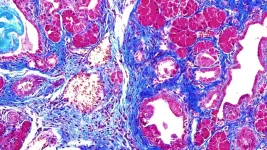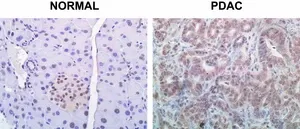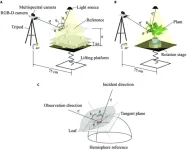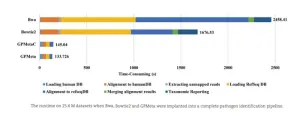(Press-News.org) Pancreatic ductal adenocarcinoma (PDAC) is the most common form of pancreatic cancer. It’s also one of the deadliest. More than 90% of PDAC patients die within five years of diagnosis. Usually, by the time the cancer is identified, it has already spread.
“PDAC is often found too late for treatments like chemotherapy and surgery to be very effective,” Cold Spring Harbor Laboratory (CSHL) Professor Adrian Krainer says. “But if we can clearly understand the underlying genetic mechanisms of PDAC, this might lead to earlier diagnoses and new types of therapies.”
Krainer and CSHL Postdoc Ledong Wan partnered with CSHL Professor David Tuveson to explore the role of a genetic process called RNA splicing in pancreatic cancer. RNA splicing helps DNA deliver instructions to cells for protein production. The team zeroed in on a splicing-regulator protein called SRSF1. They found that high levels of SRSF1 cause inflammation, or pancreatitis. This jumpstarts PDAC tumor development.
“Cells have several processes to keep SRSF1 levels constant,” says Krainer. “But cancer tends to find a way to overcome these checks and balances.”
Several genes, RNAs, and proteins work together in cells to keep SRSF1 levels steady. But sometimes, the process gets disrupted. In the pancreas, this triggers pancreatitis and accelerates PDAC.
“It’s a very pronounced effect,” Krainer explains. “We could see that patients whose tumors express higher levels of SRSF1 have worse outcomes. So, we set out to explore to what extent SRSF1 contributes to PDAC.”
The team found that higher levels of SRSF1 are essential for PDAC growth in mice and organoids—small versions of tumors. Furthermore, when SRSF1 returned to normal levels, the organoids stopped growing. SRSF1 is important in healthy tissue, so it may not be an ideal drug target by itself. However, some of the splicing changes it promotes could be targeted instead. Krainer says there is still more work to be done.
“We’re excited by these developments,” he says. “But PDAC is a difficult and complicated malignancy. We’re hoping to provide actionable information for future treatments. This work spearheaded by Ledong is just the tip of the iceberg.”
Krainer and Wan’s collaboration with the Tuveson lab is part of a broader effort to explore pancreas and breast cancer. The initiative also includes CSHL Professors David Spector and Christopher Vakoc.
“The Krainer lab’s paradigm-shifting work has led to a deeper understanding of many types of cancer,” says Tuveson, director of the CSHL Cancer Center. “Dr. Wan’s research reveals an exciting new avenue to understand pancreatic cancer. It reaffirms the importance of basic biological research for the improvement of human health.”
END
This killer protein causes pancreatic cancer
2023-04-26
ELSE PRESS RELEASES FROM THIS DATE:
Novel ‘registration’ method identifies plant traits in close-up photos
2023-04-26
Modern cameras and sensors, together with image processing algorithms and artificial intelligence (AI), are ushering in a new era of precision agriculture and plant breeding. In the near future, farmers and scientists will be able to quantify various plant traits by simply pointing special imaging devices at plants. However, some obstacles must be overcome before these visions become a reality. A major issue faced during image-sensing is the difficulty of combining data from the same plant gathered from multiple image sensors, also known as ‘multispectral’ or ‘multimodal’ ...
Introducing GPMeta: Ultrarapid GPU-accelerated pathogen identification approach
2023-04-26
Metagenomic sequencing (mNGS) is a powerful diagnostic tool to detect causative pathogens in clinical microbiological testing. Rapid and accurate classification of metagenomic sequences is a critical procedure for pathogen identification in the dry-lab step of mNGS tests. However, this crucial step may be improved by classifying sequences within a clinically relevant timeframe.
To address this challenge, a BGI Genomics team led by Xuebin Wang has recently launched GPMeta, an ultra-fast pathogen detection approach, and published these highlights ...
Alarming rates of teen suicide continue to increase in the US
2023-04-26
In the United States suicide has become the second leading cause of premature death among those ages 10 to 24; it is the leading cause of death among teens ages 13 to 14.
Researchers from Florida Atlantic University’s Schmidt College of Medicine and collaborators conducted a study exploring trends in rates of suicide among 13 to 14 year olds in the U.S. from 1999 to 2018. They also explored possible modifications by sex, race, level of urbanization, census region, month of the year and day of the week.
Results, published online ahead of print in the journal Annals of Pediatrics and Child Health, showed that among children ages 13 to 14, suicide rates ...
Thinking About an Unconventional Spelling for Your New Product or Service? You May Want to Reconsider
2023-04-26
Researchers from University of Notre Dame and The Ohio State University published a new Journal of Marketing study that examines how the use of unconventional spellings of a brand name impacts consumers’ inferences about and willingness to support the brand.
The study, forthcoming in the Journal of Marketing, is titled “‘Choozing’ the Best Spelling: Consumer Response to Unconventionally Spelled Brand Names” and is authored by John P. Costello, Jesse Walker, and Rebecca Walker Reczek.
Choosing a brand ...
Degrading viral RNA to treat SARS-CoV-2 infection
2023-04-26
Development of vaccines against SARS-CoV-2 has been rapid, but the rise of variants forces scientists to frequently modify treatments. Ideally, therapies would target mutation-resistant viral proteins, but this has proven difficult. Researchers reporting in ACS Central Science, however, have now developed a system that directly targets and degrades the viral RNA genome, reducing infection in mice. The method could be adapted to fight off many viruses, as well as treat various diseases.
Vaccines and antiviral drugs typically target proteins critical to viral infection and replication. This ...
U.S. adults who felt discrimination at work faced increased risk of high blood pressure
2023-04-26
Research Highlights:
U.S. adults who reported feeling highly discriminated against at work had an increased risk of developing high blood pressure than those who reported low discrimination at work.
Researchers suggest government and employer anti-discrimination policies and interventions may help to eliminate discrimination in the workplace.
Embargoed until 4 a.m. CT/5 a.m. ET Wednesday, April 26, 2023
DALLAS, April 26, 2023 — U.S. adults who reported feeling discriminated against at work had a higher risk for developing high ...
Innovative treatment targets blood clots without increased bleeding risk
2023-04-26
Safer and more effective blood thinners could be on the way following a groundbreaking discovery by researchers at UBC and the University of Michigan, published today in Nature Communications.
By combining their expertise in blood clotting systems and chemical synthesis, the researchers have designed a new compound called MPI 8 that offers the potential to prevent blood clots without any increased risk of bleeding—a common side effect of existing blood thinners.
“The development of MPI 8 represents a major breakthrough in the field of blood clot prevention and treatment,” said Dr. Jay Kizhakkedathu, a professor and Canada Research ...
Researchers show genetic basis of facial changes in Down Syndrome
2023-04-26
Researchers at the Francis Crick Institute, King’s College London and University College London have shed light on the genetics behind changes in the structure and shape of the face and head in a mouse model of Down Syndrome.
Described in a paper published today in Development, the researchers found that having a third copy of the gene Dyrk1a and at least three other genes were responsible for these changes taking place in development – called craniofacial dysmorphology – which involve shortened back-to-front length and widened diameter of the head.
Affecting ...
Gestational weight gain z scores, standardized by pre-pregnancy BMI, associated with susceptibility to autism-related traits
2023-04-26
ROCKVILLE, Md.—Gestational weight gain may be associated with autism-related behaviors among children who have a greater pre-disposition to these behaviors and who have mothers with pre-pregnancy overweight or obesity, according to a new study in Obesity, The Obesity Society’s (TOS) flagship journal.
Excessive gestational weight gain has been associated with neurodevelopmental outcomes in children, including autism spectrum disorder and related traits. However, it is unclear how pre-pregnancy body mass index (BMI) or familial susceptibility to autism spectrum disorder influences the gestational weight gain-autism traits association, ...
Longer siestas linked to higher risk of obesity, metabolic syndrome, and high blood pressure
2023-04-26
It is a common custom in some countries for individuals to take a siesta or midday nap. Sleeping during the middle of the day has the potential to affect sleep quality, cognitive function, and metabolic processes. However, the relationship between siestas and metabolic health is not well understood. A new study led by investigators from Brigham and Women’s Hospital, a founding member of the Mass General Brigham healthcare system, assessed more than 3,000 adults from a Mediterranean population, examining the relationship of siestas and siesta duration with obesity and metabolic syndrome. The researchers found that those who took siestas of 30 minutes or longer (long siestas) were more ...




